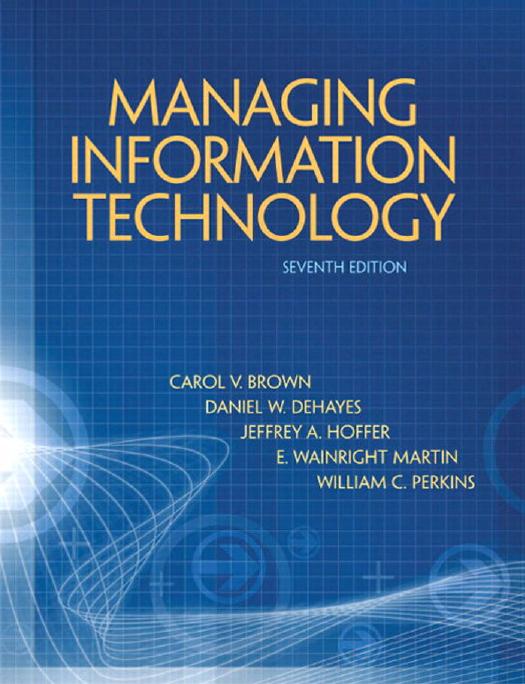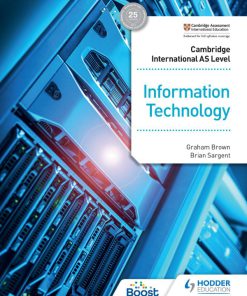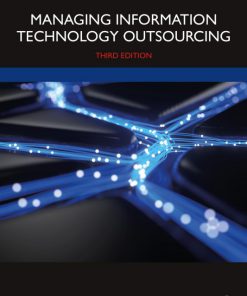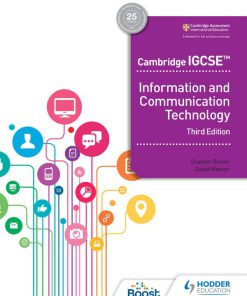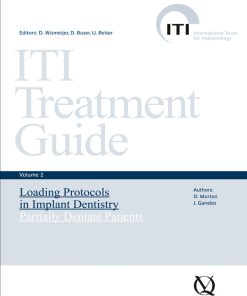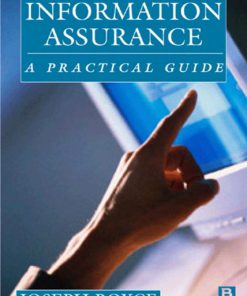Managing Information Technology 7th Edition by Jeffrey Slater, Carol Brown, Daniel DeHayes, Wainright Martin, William Perkins ISBN 9780133469004 013346900X
$50.00 Original price was: $50.00.$25.00Current price is: $25.00.
Authors:Carol V. Brown; Daniel W. Dehayes; Jeffrey A. Hoffer; Wainright E. Martin; William C. Perkins , Series:IT & Computer [256] , Tags:Business & Economics; Information Management , Author sort:Brown, Carol V. & Dehayes, Daniel W. & Hoffer, Jeffrey A. & Martin, Wainright E. & Perkins, William C. , Ids:Google; 9780132146326 , Languages:Languages:eng , Published:Published:Mar 2012 , Publisher:Pearson Prentice Hall , Comments:Comments:A thorough and practical guide to IT management practices and issues. KEY TOPICS: Managing IT in a Digital World; Computer Systems; Telecommunications and Networking; The Data Resource; Enterprise Systems; Managerial Support Systems; E-Business Systems; Basic Systems Concepts and Tools; Methodologies for Custom Software Development; Methodologies for Purchased Software Packages; IT Project Management; Planning Information Systems Resources; Leading the Information Systems Function; Information Security; Legal, Ethical, and Social Issues MARKET: For managers seeking to enhance their understanding of IS management.
Managing Information Technology 7th Edition by Jeffrey Slater, Carol Brown, Daniel DeHayes, Wainright Martin, William Perkins – Ebook PDF Instant Download/Delivery. 9780133469004 ,013346900X
Full download Managing Information Technology 7th Edition after payment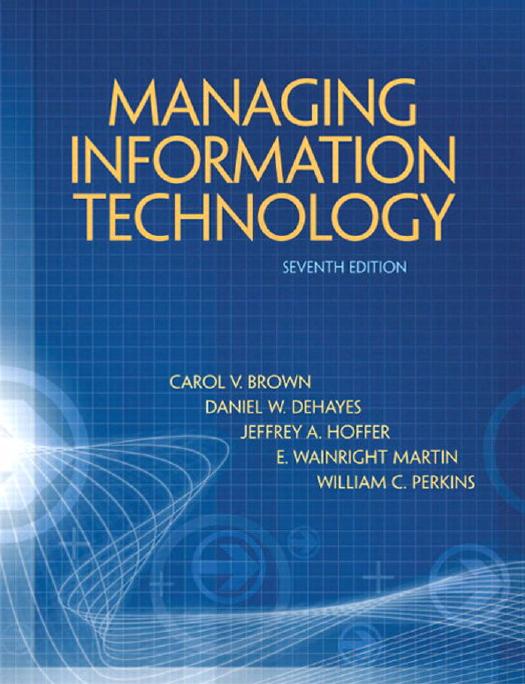
Product details:
ISBN 10: 013346900X
ISBN 13: 9780133469004
Author: Jeffrey Slater, Carol Brown, Daniel DeHayes, Wainright Martin, William Perkins
Managing Information Technology 7th Edition Table of contents:
Chapter 1 Managing IT in a Digital World
Recent Information Technology Trends
Computer Hardware: Faster, Cheaper, Mobile
Computer Software: Integrated, Downloadable, Social
Computer Networks: High Bandwidth, Wireless, Cloudy
New Ways to Compete
New Ways to Work
Managing IT in Organizations
Managing IT Resources
Technology Infrastructure
Human Resources
Business/IT Relationships
IT Leadership Roles
The Topics and Organization of This Textbook
Review Questions
Discussion Questions
Bibliography
CASE STUDY 1 Midsouth Chamber of Commerce (A): The Role of the Operating Manager in Information Systems
Background of the MSCC
Leon Lassiter
Information Technology Use at the MSCC
The Marketing and Sales Division
Operations Division
Human Resources Division
Changing Times
Catalyst for Change
Planning the New Information Technology System
The Proposal
Implementation
The Final Phase
The Future
Part 1 Information Technology
Chapter 2 Computer Systems
Basic Components of Computer Systems
Underlying Structure
Input/Output
Computer Memory
Bits and Coding Schemes
Arithmetic/Logical Unit
Computer Files
Sequential Access Files
Direct Access Files
Control Unit
The Stored-Program Concept
Types of Computer Systems
Microcomputers
Midrange Systems
Mainframe Computers
Supercomputers
Key Types of Software
Applications Software
An Example of an Application Product
Personal Productivity Software
Word Processing
Spreadsheets
Database Management Systems
Presentation Graphics
Electronic Mail and Groupware
Office Suites
World Wide Web Browsers
Other Personal Productivity Products
Support Software
The Operating System
Advanced Operating Systems Concepts6
Sources of Operating Systems
Language Translators
Third Generation Languages
COBOL
Other Procedural Languages
Fourth Generation Languages
Beyond the Fourth Generation Languages
Markup Languages
Object-Oriented Programming
Languages for Developing Web Applications
Database Management Systems
Managing the Data Resource
CASE Tools
Communications Interface Software
Utility Programs
The Changing Nature of Software
The Information Technology Industry
Summary
Review Questions
Discussion Questions
Bibliography
Chapter 3 Telecommunications and Networking
The Need for Networking
Sharing of Technology Resources
Sharing of Data
Distributed Data Processing and Client/Server Systems
Enhanced Communications
Marketing Outreach
An Overview of Telecommunications and Networking
Key Elements of Telecommunications and Networking
Analog and Digital Signals
Speed of Transmission
Types of Transmission Lines
Transmission Media
Twisted Pair
Coaxial Cable
Wireless
Satellite
Fiber Optics
Topology of Networks
Bus
Ring
Star
Tree
Mesh
More Complex Networks
Types of Networks
Computer Telecommunications Networks
Local Area Networks
Wired Local Area Networks.
Wireless Local Area Networks.
Higher-Speed Wired Local Area Networks.
Backbone Networks
Wide Area Networks
DDD and WATS.
Leased Lines.
Satellite.
ISDN.
Packet-Switched Networks.
Virtual Private Networks.
Internet
Accessing the Internet.
Intranets.
Internet2
Network Protocols
OSI Reference Model
Application Layer.
Presentation Layer.
Session Layer.
Transport Layer.
Network Layer.
Data Link Layer.
Physical Layer.
TCP/IP
The Exploding Role of Telecommunications and Networking
Online Operations
Connectivity
Electronic Data Interchange and Electronic Commerce
Marketing
The Telecommunications Industry
Summary
Review Questions
Discussion Questions
Bibliography
Chapter 4 The Data Resource
Why Manage Data?
Technical Aspects of Managing the Data Resource
The Data Model and Metadata
Data Modeling
Database Programming
Managerial Issues in Managing Data
Principles in Managing Data
The Need to Manage Data Is Permanent
Data Can Exist at Several Levels
Application Software Should Be Separate from the Database
Application Software Can Be Classified by How They Treat Data
Application Software Should Be Considered Disposable
Data Should Be Captured Once
There Should Be Strict Data Standards
Master Data Must Conform
The Data Management Process
Data Management Policies
Data Ownership
Data Administration
Summary
Review Questions
Discussion Questions
Bibliography
Part 2 Applying Information Technology
Chapter 5 Enterprise Systems
Application Areas
Critical Concepts
Batch Processing versus Online Processing
Functional Information Systems
Vertical Integration of Systems
Distributed Systems
Client/Server Systems
Virtualization
Service-Oriented Architecture and Web Services
Transaction Processing Systems
Payroll System
Order Entry System
Enterprise resource Planning Systems
An Example ERP System: SAP ERP
Data Warehousing
Customer Relationship Management Systems
Office Automation
Videoconferencing
Electronic Mail
Groupware and Collaboration
An Example Groupware System: Lotus Notes
Intranets and Portals
Factory Automation
Engineering Systems
Manufacturing Administration
Factory Operations
Robotics
Supply Chain Management Systems
Summary
Review Questions
Discussion Questions
Bibliography
Chapter 6 Managerial Support Systems
Decision Support Systems
Data Mining
Group Support Systems
Geographic Information Systems
Business Adopts Geographic Technologies
What’s Behind Geographic Technologies
Issues for Information Systems Organizations
Executive Information Systems/Business Intelligence Systems
Knowledge Management Systems
Two Recent KMS Initiatives within a Pharmaceutical Firm
Corporate KMS
Field Sales KMS
KMS Success
Artificial Intelligence
Expert Systems
Obtaining an Expert System
Examples of Expert Systems
Neural Networks
Virtual Reality
Summary
Review Questions
Discussion Questions
Bibliography
Chapter 7 E-Business Systems
Brief History of the Internet
E-Business Technologies
Legal and Regulatory Environment
Strategic E-Business Opportunities (and Threats)
B2B Applications
B2C Applications
Two Dot-Com Retailers
Amazon.com ( www.amazon.com)
Netflix ( www.netflix.com)
Two Traditional Catalog Retailers
Dell ( www.dell.com)
Lands’ End ( www.landsend.com)
Two Traditional Store Retailers
Staples ( www.staples.com)
Tesco ( www.tesco.com)
Summary: B2C Retailing
The Initial Dot-Com Advantage
Today’s Multichannel Advantage
Dot-Com Intermediaries
Summary: Successful Online Intermediary Models
Special Issue: What Makes a Good Web Site for consumers
Special Issue: What Makes a Good B2C Social Media Platform
Summary
Review Questions
Discussion Questions
Bibliography
Part 3 Acquiring Information Systems
Chapter 8 Basic Systems Concepts and Tools
The Systems View
What Is a System?
Seven Key System Elements
System Boundary
Component Decomposition
Interfaces
Organizations as Systems
Systems Analysis and Design
System Scope
Logical Before Physical
Problem-Solving Steps
Business Processes
Identifying Business Processes
Business Process Redesign
Accounts Payable at Ford Motor Company
Mutual Benefit Life Insurance
IT as an Enabler of BPR
Processes and Techniques to Develop Information Systems
The Information Systems Development Life Cycle
Structured Techniques for Life-Cycle Development
Procedural-Oriented Techniques
Techniques for the As-Is Model
Techniques for the Logical To-Be Model
To-Be Patterns
Techniques for Documenting the Physical To-Be System
Object-Oriented Techniques
Core Object-Oriented Concepts
Summary of Processes and Techniques to Develop Information Systems
Information Systems Controls to Minimize Business Risks
Types of Control Mechanisms
Controls in the Definition and Construction Phases
Methodology Standards
Validation Rules and Calculations
System Testing
Controls in the Implementation Phase
Security
Backup and Recovery
Auditing Roles
Summary
Review Questions
Discussion Questions
Bibliography
Chapter 9 Methodologies for Custom Software Development
Systems Development Life Cycle Methodology
The SDLC Steps
Initiating New Systems Projects
Definition Phase
Feasibility Analysis
Requirements Definition
Construction Phase
System Design
System Building
System Testing
Implementation Phase
Installation
Operations
Maintenance
The SDLC Project Team
Managing an SDLC Project
Manageable Project Size
Accurate Requirements Definition
Executive Sponsorship
SDLC Advantages and Disadvantages
Prototyping Methodology
The Prototyping Steps
The Prototyping Project Team
Managing a Prototyping Project
Prototyping Advantages and Disadvantages
Prototyping Within an SDLC Process
Newer Approaches
Rapid Application Development (RAD)
Agile Methodologies
eXtreme Programming
Scrum
Managing Software Projects Using Outsourced Staff
Supporting User Application Development (UAD)
Advantages and Disadvantages of User-Developed Applications
Assessing the Risks from UAD
Application Characteristics
Tool Characteristics
Developer Characteristics
Guidelines for User Developers
Summary
Review Questions
Discussion Questions
Bibliography
Chapter 10 Methodologies for Purchased Software Packages
The Make-or-Buy Decision
Purchasing Methodology
The Purchasing Steps
Initiating the Purchasing Process
Definition Phase
Feasibility Analysis
Requirements Definition
Create Short List of Suitable Packages
Establish Criteria for Selection
Develop and Distribute the RFP
Evaluate Vendor Responses to RFP and Choose Package
Negotiate Contract
Construction Phase
Implementation Phase
Installation
Operations
Maintenance
Project Team for Purchasing Packages
Managing a Purchased System Project
Purchasing Small Systems
Purchasing Advantages and Disadvantages
Advantages
Disadvantages
Special Case: Enterprise System Packages
Open Source Software
New Purchasing Option: Application Service Providers (ASPs)
Summary
Review Questions
Discussion Questions
Bibliography
Chapter 11 IT Project Management
IT Portfolio Management
Project Management Roles
Project Manager
Project Sponsor and Champion Roles
Project Initiation
Project Planning
Scheduling
Budgeting
Staffing
Planning Documents
Project Execution and Control
Managing Project Risks
Managing Business Change
Project Closing
Special Issue: Managing Complex IT Projects
Special Issue: Managing Virtual Teams
Summary
Review Questions
Discussion Questions
Bibliography
Part four The Information Management System
Chapter 12 Planning Information Systems Resources
Benefits of Information Resources Planning
Creating a Context for IS Resource Decisions
Aligning IS and Business Goals
Balancing the Trade-offs Between Standardization and Agility
Obtaining IT Capital Investment Approvals
The Information Resources Planning Process
Assessing The Current Information Resources
Measuring IS Use and Attitudes
Reviewing the IS Organizational Mission
Assessing Performance Versus Goals
Creating an Information Vision
Designing the IT Architecture
Formulating the Strategic IS Plan
The Strategic IS Planning Process
Setting Objectives
Conducting Internal and External Analyses
Establishing Strategic Initiatives
Tools for Identifying Strategic IT Opportunities
Critical Success Factors
Analysis of Competitive Forces
Value Chain Analysis
Formulating Operational IS Plans
Guidelines for Effective IS Planning
Summary
Review Questions
Discussion Questions
Bibliography
Chapter 13 Leading the Information Systems Function
IS Organization responsibilities and Governance
Managing IT Service Delivery
Chargeback Systems
Service Level Agreements (SLAs)
IT Service Management with ITIL
Supporting Computer Users
Strategies for User Computing
Support Services for Computer Users
Control Policies and Procedures
Supporting Telecommuters
Managing IT Applications
An Applications Portfolio Approach
Metrics for IT Applications Management
Managing IT Human Resources
Managing the Business/IT Relationship
Measuring Overall IS Performance
Special Issue: is management in Global organizations
Special Issue: Managing it Outsourcing
Summary
Review Questions
Discussion Questions
Bibliography
Chapter 14 Information Security
Computer Crime
The Chief Security Officer Role
Risk Management for Information Security
Compliance with Laws and Regulations
Sarbanes-Oxley (SOX)
Gramm-Leach-Bliley Act of 1999 (GBLA)
The Financial Privacy Rule
Health Insurance Portability and Accountability Act (HIPAA)
The PATRIOT Act
Organizational Polices for Information Security
Planning for Business Continuity
Electronic Records Management (ERM)
Summary
Review Questions
Discussion Questions
Bibliography
Chapter 15 Social, Ethical, and Legal Issues
The Legal Environment
Ethics Frameworks
Identifying Ethical Problems
Analyzing Ethical Problems
Social issues
Privacy
Privacy Problems
E-Commerce Privacy Concerns
Workplace Privacy
Ethics of Invasion of Privacy
Laws on Privacy
Identity Theft
Impact of Identity Theft
Laws on Identity Theft
Intellectual Property Rights
Software Piracy
Copyright Protection
Patent Protection
Digital Entertainment Piracy
Internet File Sharing
Ethical Questions
Other Social Issues
Access to the Technology
Freedom of Speech
Hazards of Inaccuracy
Impact on Workers
The Future
Review Questions
Discussion Questions
Bibliography
Glossary
Index
People also search for Managing Information Technology 7th Edition:
managing information technology projects
managing information technology ppt
managing information technology test bank
managing information technology francisco castillo

